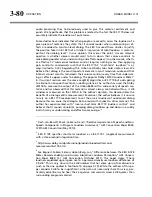
OPTIMOD-PC
OPERATION
3-77
Test Setup
A stereo recording of approximately 30 minutes of unprocessed audio from the out-
put of the master control of a San Francisco network station was applied to the 2.0
processing chain of an Optimod-Surround 8685 processor, set for normal operation
using its TV 5B GEN PURPOSE preset. The digital output of the processor was applied
to the digital input of an Orban 1101 soundcard, which was adjusted to pass the au-
dio without further processing and to apply it to an Orban software-based loudness
meter that simultaneously computes the BS.1770-2 Integrated loudness and CBS
loudness. The first 750-second segment of the program material was a daytime dra-
ma with commercial and promotional breaks, while the remainder was local news,
also with commercial and promotional breaks.
The BS.1770-2 meter was adjusted to produce a 10-second integration window in
which, per the BS.1770 standard, all data are equally weighted. The CBS Loudness
Gain control was set to –3.12 dB. Data were logged every 10 seconds and included
the maximum meter indication produced by both the BS.1770 and CBS meters in
each 10-second interval. This produced 165 data points, which were imported into a
scientific plotting application
.
Orban’s experimental long-term loudness measurement, based on the CBS meter
and first published in 2008, was also included in the measurements and is shown in
the bottommost charts. This algorithm attempts to mimic a skilled operator’s mental
integration of the peak swings of a meter with “VU-like” dynamics. The operator
will concentrate most on the highest indications but will tend to ignore a single high
peak that is atypical of the others. This algorithm can be seen to share certain char-
acteristics with the floating gate first introduced in EBU R 128 and later adopted in
BS.1770-2.
The Orban algorithm displays the average of the peak indications of the meter over
a user-determined period: 10 seconds for these measurements. The average is per-
formed before dB conversion. All peak indications within the period are weighted
equally with the following exceptions:
•
If the maximum peak in the window is more than 3 dB higher than the sec-
ond highest peak, it is discarded.
•
All peaks more than 6 dB below the maximum (or second-to-maximum, if
the maximum peak was discarded) are discarded.
Because the CBS long-term measurement discards a single peak if it is more than 3
dB higher than the second highest peak, the CBS long-term measurement tends to
be biased about 3 dB lower than a measurement that shows the maximum peak in-
dication of the CBS meter in a 10-second period. This depends on whether or not the
loudness applied to the meter’s input is well controlled. This bias can be seen in the
figures in the paper. Because the Orban meter allows control of the level applied to
6
PSI Plot:
http://www.polysoftware.com/plot.htm
Summary of Contents for Optimod-PC 1101
Page 4: ......
Page 14: ......
Page 121: ...OPTIMOD PC OPERATION 3 1 Section 3 Operation Figure 3 1 The OPTIMOD PC Control Application...
Page 192: ...3 72 OPERATION ORBAN MODEL 1101...
Page 204: ......
Page 210: ......
Page 212: ...5 2 UNINSTALLATION ORBAN MODEL 1101...
Page 236: ......
















































